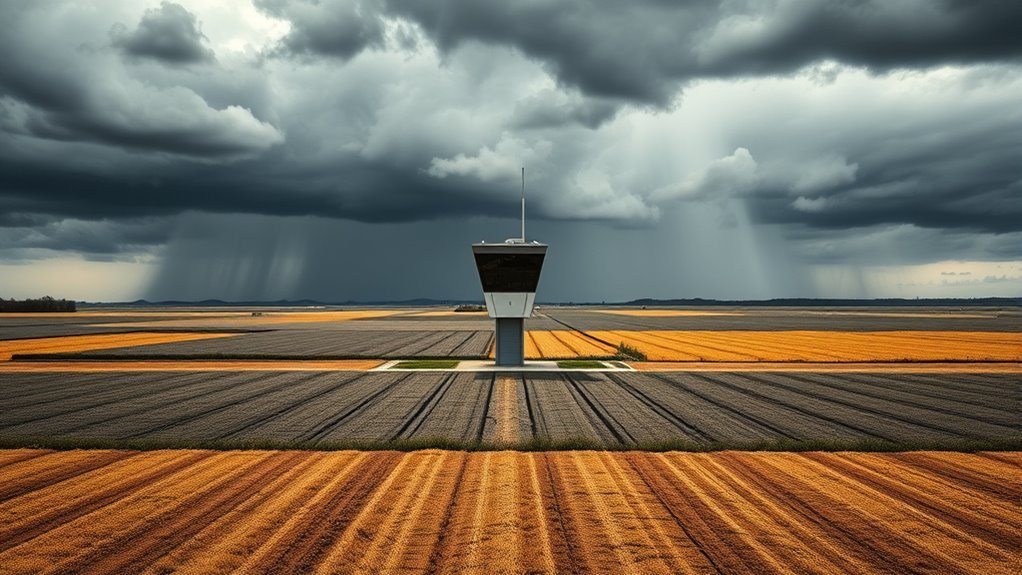Farmers prepare for squalls by employing various strategies to safeguard their crops from wind damage. They monitor weather patterns using advanced technologies, ensuring timely alerts. Selecting resilient crop varieties boosts resistance to harsh conditions. Implementing soil and crop management practices, such as crop rotation and cover cropping, advances overall well-being. Constructing windbreaks with trees and shrubs mitigates wind impact. Emergency response plans are essential for swift action during storms. More effective strategies for protection are investigated as conditions change.
Main Points
- Farmers utilize advanced weather monitoring technologies for real-time updates on squalls to anticipate severe weather events.
- Developing and regularly updating emergency response plans ensures all farm members know their roles during storm situations.
- Implementing resilient crop management practices, such as selecting wind-resistant varieties, helps minimize damage from strong winds.
- Constructing windbreaks using trees or shrubs alters wind patterns and protects crops from harsh weather conditions.
- Engaging in community collaboration fosters information sharing and support systems to enhance preparedness and response to squalls.
Understanding Squalls and Their Impact on Agriculture
Although squalls are often brief, their sudden onset can greatly disrupt agricultural operations. These intense, localized storms can bring heavy rain, strong winds, and hail, posing considerable risks to crops. Their unpredictable nature means that farmers may not have adequate time to implement protective measures.
Damage from wind can lead to physical destruction of plants, uprooting young seedlings and trampling mature crops. Additionally, the heavy rainfall associated with squalls can cause soil erosion and waterlogging, adversely affecting root systems and nutrient availability. This disruption can result in reduced yields, impacting both the immediate harvest and long-term crop viability.
Farmers must remain vigilant and flexible, understanding the potential impact of squalls on their operations. By recognizing the characteristics and risks associated with these weather events, they can better prepare for the inevitable challenges that arise during the growing season.
Weather Monitoring Technologies and Tools

As farmers face the challenges posed by squalls, leveraging advanced weather monitoring technologies becomes essential for effective decision-making.
These tools enable farmers to receive real-time data on weather conditions, enhancing their ability to anticipate severe weather events. Systems such as Doppler radar and satellite imagery provide vital insights into wind patterns, precipitation, and storm trajectories, allowing for timely alerts.
Additionally, on-site weather stations equipped with sensors measure temperature, humidity, and wind speed, offering localized forecasts that can be significant for small-scale farming operations.
Mobile applications further enable farmers by delivering instant notifications and forecasts directly to their gadgets, allowing for quick responses to impending squalls.
Selecting Resilient Crop Varieties
When farmers prioritize resilience in their crops, selecting varieties that can withstand severe weather events, such as squalls, becomes essential. This selection process involves evaluating specific traits that contribute to durability, including root structure, stem strength, and leaf flexibility.
Farmers often turn to research and data on crop performance under adverse conditions to guide their choices. Hybrid and genetically modified varieties may offer improved resistance to wind damage and flooding, making them attractive options.
Additionally, local agricultural extension services frequently provide guidance into varieties that have historically thrived in the region's climate.
Farmers also consider the trade-offs between yield potential and resilience, aiming to strike a balance that guarantees food security while minimizing losses.
Implementing Soil and Crop Management Practices

Farmers are increasingly recognizing the importance of implementing effective soil and crop management practices to improve resilience against unpredictable weather patterns.
Techniques such as crop rotation can greatly improve soil health and reduce pest pressures, while soil fertility improvement methods guarantee that crops receive essential nutrients.
Crop Rotation Techniques
While unpredictable weather patterns pose challenges to agriculture, effective crop rotation techniques can improve soil health and crop resilience.
Farmers employ these strategies to alternate the types of crops planted in a specific field over different seasons or years. This practice minimizes soil depletion by ensuring that nutrients are replenished, as different crops utilize different soil nutrients.
Additionally, crop rotation helps disrupt pest and disease cycles, reducing the likelihood of infestations that can devastate yields. By diversifying crop types, farmers also encourage biodiversity, which contributes to a more robust ecosystem.
In general, implementing crop rotation techniques not only aids in protecting crops from adverse weather conditions but also cultivates sustainable farming practices that support long-term agricultural productivity.
Soil Fertility Enhancement
Although soil fertility is essential for crop productivity, many farmers struggle to maintain it amid changing environmental conditions.
To improve soil fertility, farmers can implement various soil and crop management practices. These practices not only sustain crop yields but also contribute to long-term soil health.
- Cover Cropping: Prevents erosion and enriches soil organic matter.
- Organic Amendments: Enhances nutrient availability and soil structure.
- Soil Testing: Identifies nutrient deficiencies for targeted interventions.
- Conservation Tillage: Reduces soil disturbance, promoting microbial life and nutrient cycling.
Constructing Windbreaks and Barriers

To mitigate the impact of harsh winds, constructing windbreaks and barriers has become essential for agricultural resilience. Farmers utilize various materials, such as trees, shrubs, and fences, to create effective windbreaks that shield crops from damaging gusts. These structures not only reduce wind speed but also minimize soil erosion, thereby enhancing overall soil health.
Strategically placed windbreaks can alter wind patterns, directing harmful winds upward and away from vulnerable crops. The selection of appropriate species for living windbreaks is critical, as these plants must withstand local weather conditions and encourage biodiversity.
In addition to trees, farmers may opt for artificial barriers, including nets or fabric, to provide immediate protection during severe weather events.
Ultimately, the thoughtful construction of windbreaks and barriers plays an essential role in safeguarding agricultural yields, ensuring that farmers can maintain productivity even in the face of unpredictable squalls.
Utilizing Protective Structures and Covers
As farmers confront the challenges posed by squalls, utilizing protective structures and covers has emerged as a critical strategy to safeguard their crops.
These measures not only prevent wind damage but also improve overall resilience against unpredictable weather conditions. Protective structures, such as greenhouses and high tunnels, create a controlled environment that can shield crops from harsh winds and flying debris.
Additionally, covers such as row tarps and netting provide an extra layer of security, allowing crops to thrive even during tumultuous weather.
Farmers often rely on:
- Greenhouses: Offering a robust shield against strong winds.
- Row Covers: Protecting young plants from wind and temperature fluctuations.
- Windbreak Nets: Reducing wind speed and minimizing damage.
- Plastic Films: Providing insulation and protecting against moisture loss.
These protective measures symbolize farmers' determination to nurture their crops amidst nature's fury.
Emergency Response Plans for Severe Weather Events
Farmers must establish effective emergency response plans to mitigate the impacts of severe weather events.
This involves conducting thorough risk assessment procedures to identify potential threats to their operations.
Additionally, implementing robust communication strategies guarantees that all stakeholders are informed and prepared to act swiftly in the face of impending storms.
Risk Assessment Procedures
When severe weather threatens agricultural operations, effective risk assessment procedures become essential for minimizing damage and ensuring safety. Farmers systematically evaluate their vulnerability to storms, focusing on both crops and infrastructure. This proactive approach allows them to implement timely measures to mitigate potential losses.
Key components of risk assessment include:
- Identifying high-risk areas: Recognizing fields more susceptible to wind damage.
- Evaluating crop maturity: Understanding which plants are most vulnerable at different growth stages.
- Assessing structural integrity: Checking barns and storage facilities to withstand severe winds.
- Planning evacuation routes: Ensuring swift and safe movement of livestock and equipment.
These procedures not only protect the harvest but also safeguard the livelihoods of farmers and their communities.
Communication Strategies Implemented
Effective communication strategies are essential for implementing emergency response plans during severe weather events. Farmers utilize various channels to disseminate critical information, ensuring timely updates about impending squalls.
Mobile apps, weather alert systems, and social media platforms serve as primary tools for rapid communication among agricultural communities. Regular training sessions are conducted to familiarize farmers with these tools, enhancing their preparedness.
Additionally, establishing local networks encourages collaboration and information sharing, enabling farmers to respond swiftly to weather alerts. Clear protocols outlining roles and responsibilities are also developed, ensuring that each member knows their tasks during a storm.
Common Questions
How Do Squalls Differ From Other Types of Storms?
Squalls are sudden, intense bursts of wind and rain, differing from other storms by their brief duration and rapid onset. Unlike prolonged storms, squalls can cause immediate, localized disruptions, impacting visibility and safety for those caught unaware.
What Crops Are Most Susceptible to Wind Damage?
Certain crops, such as corn, sunflowers, and tomatoes, are particularly vulnerable to wind damage. Their tall structures and delicate fruits make them susceptible to bending, breaking, or detaching during strong gusts and severe weather events.
Can Squalls Occur in Any Season?
Squalls can indeed occur in any season, defined by sudden bursts of strong winds and precipitation. Their unpredictable nature poses challenges for various environments, affecting both natural scenery and human activities throughout the year.
How Do Farmers Assess Wind Damage After a Squall?
Farmers assess wind damage after a squall by inspecting crops and structures for broken branches, uprooted plants, and debris. They often document findings, utilize aerial imagery, and consult weather data to evaluate total impact and recovery needs.
What Role Do Insurance Policies Play in Protecting Crops?
Insurance policies serve as a financial safety net for farmers, mitigating losses from unforeseen weather events. They provide compensation for damaged crops, helping farmers recover quickly and maintain their livelihoods amidst the unpredictability of nature.

